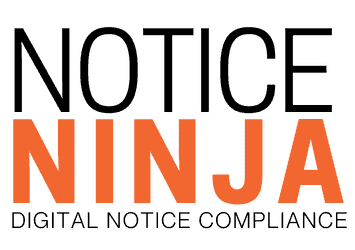Yes, NOTICENINJA is corporate tax notice compliance software that automates key workflows including notice assignments. The platform employs a rule-based system that can manage multiple level rules and ensure notices are directed to the appropriate stakeholder. As a result, you’ll never have to worry about notices being misdirected or slipping between the cracks.

The Definitive Guide to Understanding Regulatory Complexity
.png?width=1000&name=Amanda%20Reineke%20CEO%20Co-founder%20(41).png)
22 August
Navigating the Maze: Understanding Regulatory Complexity
Regulatory complexity is a growing concern for businesses worldwide. At its core, it refers to the vast and intricate web of rules, regulations, and guidelines that companies need to comply with. Here’s the quick takeaway:
- Definition: The overwhelming amount and intricacy of rules and regulations.
- Impact: Increases operational costs and risks, complicates compliance efforts.
- Challenge: Balancing compliance with innovation and efficiency.
Understanding regulatory complexity is critical for large corporations, especially those operating across multiple states or nations. Evolving regulations, whether in finance, data protection, or taxation, add to this complexity.
Regulatory frameworks that are too complex can increase systemic risks. As highlighted by the European Systemic Risk Board, excessive regulation might give a false sense of control, creating loopholes that bad actors could exploit. For tech giants, this complexity is comparable to financial institutions' regulatory burdens, requiring robust risk and compliance management.
At Notice Ninja, we understand these challenges deeply. With our software, NOTICENINJA, we help businesses streamline their compliance efforts by providing automated solutions that ensure efficiency and accuracy.
My name is Amanda Reineke, CEO of NoticeNinja. With years of experience in digital compliance, I am passionate about simplifying regulatory complexity for businesses.

Understanding Regulatory Complexity
Navigating regulatory complexity can feel like walking through a maze. But understanding the types of regulatory approaches and the factors contributing to this complexity can make it easier to manage.
Types of Regulatory Approaches
- Command and Control: This traditional approach involves strict regulations where the government sets specific rules that businesses must follow. Think of it as a playbook where every move is dictated. While this can ensure compliance, it can also stifle innovation and flexibility.
- Performance-Based: Here, regulators set goals but allow businesses the flexibility to decide how to achieve them. For example, a company might be required to reduce emissions but can choose its method. This approach encourages innovation but can be harder to monitor.
- Management-Based: This approach requires businesses to develop their own compliance plans. It's like setting a destination but letting each company choose its path. It promotes a tailored approach but can vary widely in effectiveness.
Factors Contributing to Regulatory Complexity
- Regulatory Frameworks: The backbone of regulatory complexity. Frameworks that are too intricate can create an illusion of control, leading to unforeseen risks. According to the European Systemic Risk Board, excessive complexity can lead to systemic risk by giving regulators a false sense of security.
- Systemic Risk: Complex regulations can create loopholes, allowing bad actors to exploit the system. This is particularly concerning in the financial sector, where systemic risk can have widespread consequences.
- Regulatory Uncertainty: Unclear or frequently changing regulations make it difficult for businesses to stay compliant. This uncertainty can be costly and time-consuming, requiring constant adjustments to compliance strategies.
- Regulatory Intensity: The sheer volume and breadth of regulations can overwhelm businesses. As highlighted by KPMG, the current regulatory landscape is marked by high intensity, demanding robust risk management and compliance efforts.
- Legal Developments: New laws and amendments can add layers of complexity. For example, the introduction of the Digital Services Act has significant implications for tech companies, requiring them to adapt quickly to new rules.
- Political Uncertainty: Political changes can lead to regulatory shifts. For instance, changes in government can result in new priorities and regulations, adding to the complexity businesses must navigate.
My name is Amanda Reineke, CEO of Notice Ninja. With years of experience in digital compliance, I am passionate about simplifying regulatory complexity for businesses.
Navigating Regulatory Complexity
Building an Authoritative Source Library (ASL)
To navigate the maze of regulatory complexity, building an Authoritative Source Library (ASL) is essential. An ASL is a comprehensive inventory of your company’s compliance obligations. This includes federal and state laws, industry guidelines, and rules from self-regulatory organizations.
An ASL provides a structured foundation for your compliance program. Without it, compliance teams often scramble to save emails, bookmark webpages, and maintain paper registers. This scattered approach leads to lost data and uncertainty.
Benefits of an ASL: - Centralized Information: All compliance obligations in one place. - Consistent Structure: Information is uniformly arranged, making it easier to analyze and compare. - Regulatory Change Management: Ingesting regulatory changes keeps your library up-to-date and drives your compliance program.
For instance, mortgage companies face varying state-level regulations. An ASL helps them map obligations to specific business units and manage compliance risks effectively.
Managing Regulatory Compliance Risk
Managing regulatory compliance risk involves several key components: risk assessment, regulatory change management, and providing proof of compliance.
Risk Assessment: Start by identifying and evaluating potential compliance risks. This includes understanding your compliance obligations and the impact of regulatory changes. For example, financial institutions must assess risks stemming from both federal and state laws.
Regulatory Change Management: Regulations are constantly evolving. Effective change management means staying ahead of updates. An ASL helps by tracking changes and mapping them to your compliance obligations. This proactive approach minimizes surprises and helps you adapt quickly.
Compliance Proof: Demonstrating compliance is crucial. This involves maintaining records and documentation to show that your company meets regulatory requirements. For instance, financial institutions often need to provide proof of compliance with anti-money laundering laws.
By using NOTICENINJA, you can automate these processes, reducing the burden on your compliance team and ensuring that you stay compliant with ease.

Navigating regulatory complexity is challenging, but with the right tools and processes, you can manage it effectively. An ASL and robust compliance risk management are critical components of a successful compliance program.
The Impact of Regulatory Complexity on Businesses
Compliance Costs and Financial Impact
Complying with regulations is expensive. For instance, financial crime compliance alone cost financial institutions $274.1 billion in 2022, up from $213.9 billion in 2020. This is just one part of the overall compliance costs that also include data protection, labor laws, and taxation.
- Data Protection: With laws like the GDPR in Europe and CCPA in California, businesses must invest heavily in data security measures. Non-compliance can result in hefty fines and damage to reputation.
- Taxation: Companies face complex tax regulations that vary greatly between countries. The OECD's Base Erosion and Profit Shifting (BEPS) Action Plan aims to standardize tax rules, but differences in implementation still exist.
- Regulatory Divergence and Convergence
- Country-Specific Rules: Most regulations are country-specific. For example, there is no global labor law. Each country has its own set of rules, making compliance a complex task for multinational companies.
- OECD Standards: Organizations like the OECD set global standards, such as the Common Reporting Standard (CRS) for tax information exchange. Many countries adopt these standards, but their implementation can differ. For example, the US's corporate alternative minimum tax differs from the OECD's Pillar Two framework on global minimum tax rates.
- Global Minimum Tax: The OECD's Pillar Two framework aims to set a global minimum tax rate for large multinational groups. However, its application varies by country, adding to the complexity.
- Regulatory Convergence: Initially, many business leaders predicted that regulations would converge globally. However, recent surveys show a decline in this sentiment. Geopolitical and economic factors like the US-China trade wars and the war in Ukraine contribute to doubts about further international cooperation on regulatory initiatives.
In summary, regulatory complexity continues to challenge businesses with high compliance costs and country-specific rules. While global standards like those from the OECD aim to simplify things, differences in implementation mean that multinational companies must still navigate a complex regulatory landscape.
Regulatory complexity is a major challenge for businesses today. With changing rules and high compliance costs, companies need smart solutions to stay ahead. This is where NoticeNinja comes in.
NOTICENINJA: Your Compliance Partner
Notice Ninja helps businesses manage regulatory complexity through automation. Our platform, NOTICENINJA, streamlines compliance processes, making it easier to track and respond to regulatory changes. This means less manual work and more accuracy.
Automation: The Key to Efficiency
Automation is crucial for managing compliance efficiently. By automating tasks like data entry and notice tracking, NOTICENINJA reduces the risk of human error. This leads to quicker responses to regulatory changes and ensures that all compliance obligations are met.
Compliance Efficiency: A Competitive Edge
Efficient compliance management gives your business a competitive edge. With NOTICENINJA, you can focus on growth while we handle the complexities of regulatory compliance. Our platform offers real-time updates and detailed reporting, so you always know where you stand.
Ready to simplify your compliance process? Discover the benefits of NOTICENINJA and see how automation can help your business stay compliant and efficient.
